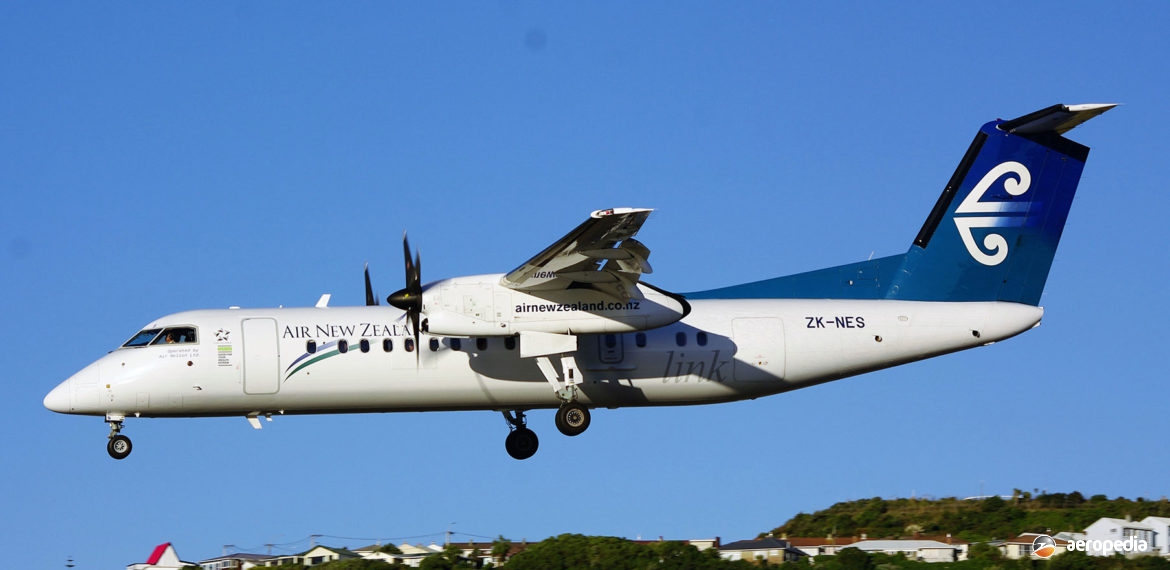Photograph:
de Havilland Canada DHC-8-311Q ZK-NES (c/n 125) at Wellington, New Zealand in April 2012 (David C Eyre)
Country of origin:
Canada
Description:
Medium range commercial airliner
Power Plant:
(Q300)
Two 1,865 kw (2,500 shp) Pratt & Whitney PW123B turboprops
Specifications:
- Wingspan: 27.43 m (90 ft)
- Length: 25.68 m (84 ft 3 in)
- Height: 7.49 m (24 ft 7 in)
- Wing area: 56.21 m² (605 sq ft)
- Max cruising speed: 532 km/h (330 mph)
- Stalling speed flaps down: 141 km/h (88 mph)
- Max rate of climb at sea level: 549 m/min (1,800 ft/min)
- Max certified altitude: 7,620 m (25,000 ft)
- Take-off field length at sea level: 1,097 m (3,600 ft)
- Landing field length at max landing weight: 1,010 m (3,315 ft)
- Range with 50 passengers and standard fuel: 1,483 km (921 miles)
- Range with 50 passengers and auxiliary fuel: 2,179 km (1,354 miles)
- Fuel capacity: 3,160 litres (695 Imp gals)
- Empty weight: 11,709 kg (25,814 lb)
- Max usable fuel: 2,576 kg (5,679 lb)
- Max payload weight: 5,166 kg (11,386 lb)
- Loaded weight: 18,642 kg (41,000 lb)
History:
A new series of the de Havilland Canada Dash-8, known as the Q300, was announced in 1985. This model had the fuselage stretched by using two fuselage plugs, one forward and one aft of the wing, increasing length by 3.43 m (11 ft 3 in). This increased seating capacity to 50 with an 81 cm (32 in) pitch, or up to 56 with a 74 cm (29 in) pitch. The wing was of 1.52 m (5 ft) greater span, had a reinforced torsion box and strengthened main undercarriage legs. Other changes included a larger re-positioned galley, a larger toilet, an additional wardrobe, dual air conditioning packs, a new galley service door and an optional Auxiliary Power Unit (APU).
The Dash-8-300 came in a number of variants, the Model 300A being introduced in 1990 and having optional higher gross weights, interior improvements and Pratt & Whitney PW123A engines with PW123Bs optional. The Model 300B was introduced in 1992 and had 1,865 kw (2,400 shp) PW123B engines as standard and an optional higher gross weight. The Model 300E had 1,775 kw (2,380 shp) PW123E engines rated to 40 degrees celcius to improve hot and high performance. From 1996 all Model 300s were fitted with computer-controlled noise and vibration suppression systems. In 1998 the Model Q300 was introduced with a new interior.
The series 300 prototype C-GDNK (c/n 1) flew on 15 May 1987, this being the prototype Dash-8-100 converted to the new configuration. Canadian certification was obtained on 14 July 1989 and first delivery was to Time Air on 27 February that year. US certification was obtained on 8 June 1989 and the type was certified in a number of countries.
The 300 series has been extensively used in Australia and New Zealand. Operators of the 300 series included Qantas Link, Sunstate Airlines, Skippers Aviation and Surveillance Australia. National Jet used examples in the Northern Territory and Western Australia for resource charters. Other operators have included Air New Zealand, Ansett New Zealand, Air Nelson and Vincent Aviation.
Over 1,300 examples of the Dash 8 series have been built.
One variant was the Dash 8 MPA (Maritime Patrol Aircraft), ten of which were delivered to Surveillance Australia in Adelaide to fulfil the Australian Customs Sentinel Contract. The first three delivered by Field Aviation in Canada were modifications of Model Dash-8-Q200, the first being delivered in 1996, two more being delivered in 2000 to fulfill the Coastwatch contract. Five Q200s were delivered, followed by four Q300s, which were ordered in 2005 following receipt of a 12 year contract, this contract being awarded on 1 January 2008. These aircraft were fitted out with sensors, operator stations and systems racks, the 300 series having extended range over the 200 series aircraft.

